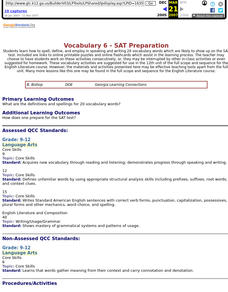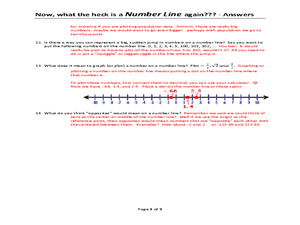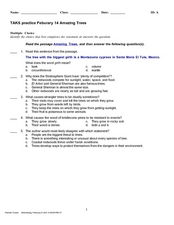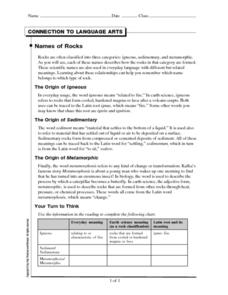Curated OER
Some Facts about Pi
In this Pi handout, 10th graders are provided with a brief history of Pi as well as mnemonics they can use to remember the digits of Pi. There are additional links on this page that provide access to more interesting facts about Pi
Curated OER
Mighty Oaks from Little Acorns
What does it mean to grow? To germinate? For the plan detailed here, class members investigate the growth process of an oak tree while focusing on the beginning stages of planting and germination. They plant seeds and record observations...
Curated OER
Visual Vocabulary
Students use context clues to determine an understanding for vocabulary words in texts. In this vocabulary lesson plan, students recognize linguistic features in their readings to help them to figure out words.
Curated OER
Auxin: Indole-3-Acetic Acid
Learners identify auxins from their structural formulas. They understand the process of refluxing in chemical synthesis. Students perform thin layer chromatography using silica gel plates to differentiate chemical substances.
Curated OER
What Are the Layers of the Rain Forest?
Students investigate the different levels of the rain forest by comparing it to an apartment. In this ecology lesson, students practice using forest related vocabulary words and complete a vocabulary data sheet. Students create...
Curated OER
Vocabulary of Ancient Rome Grades 9-12)
Students define ancient Roman vocabulary using the dictionary writing sentences.
Curated OER
The Five Number Game
Learners explain what it means to square numbers. They explain what it means to cube numbers. Students define prime numbers using their own language. They are introduced to the problem by playing one game as a class.
Curated OER
Bingo!
First graders practice and reinforce phonics and/or math skills by creating Bingo! game using computer spreadsheet. Students incorporate phonics or math skills class has been practicing onto Bingo! cards, which can be printed and made...
Curated OER
Leaf Chromatography
In this leaf chromatography worksheet, students separate the pigments of a leaf using paper chromatography. They answer 4 questions about their results and draw the colors they observe on their chromatogram from the leaf.
Curated OER
Vocabulary 6 - SAT Preparation
Young scholars discover how to spell, define, and employ in speaking and writing 20 vocabulary words which are likely to show up on the SAT test. Included are links to online printable puzzles and online flashcards.
Curated OER
Now, what the heck is a NUMBER LINE again???
A unique approach to reviewing number lines and how to locate different values on them, this worksheet poses several questions that require written answers rather than calculations. You could use this as a note-taking guide when teaching...
Curated OER
Finding Our Place in Time
Students utilize interviewing skills of an historian to research the time period of the 1970's. They use prior knowledge of the 1960's to explain the mood of the country in the 1970's.
Curated OER
Symmetry and Symbols
Students identify symmetrical and congruent elements in folk art. In this art and geometry instructional activity, students examine pictures of Masonic Plaque in the Form of a Royal Arch Tracing Board for evidence of congruent and...
Curated OER
Brown Bagging with Short Stories
Students participate in a study of short story elements, applying their knowledge and understanding to a selection of short stories. In this short stories lesson, students read five short story selections, identifying conflict, plot,...
Curated OER
TAKS Practice February 14 Amazing Trees
Are you using Amazing Trees with your pupils? This assessment could be used to gauge their understanding of one passage from the text. The referenced passage from Amazing Trees on which the worksheet is predicated is not included. Beware...
Curated OER
Presenting..... Prefixes! Hold Down the Applause, Please!
Fifth graders read and consider a list of common prefixes and their meanings. They complete a worksheet which asks them to read and define a prefix in context. They switch and evaluate each other's papers.
Curated OER
Fundamentalism
Eighth graders explore the historical roots of fundamentalism and determine whether fundamentalism is a religion or a political ideology. They will examine different religious fundamentalist movements around the world noting any...
Curated OER
Measurement: Lesson 2
Eighth graders complete math problems given in this lesson, where they find the perimeter and area of specific figures. They estimate the perimeter and area of shapes and figures and then complete the mathematical formula to find the...
Curated OER
Grammar: Adding a Prefix and Suffix
Fourth graders practice adding a prefix and/or suffix to base words. In this spelling review lesson, 4th graders review how to add a prefix and suffix to a word and complete a worksheet demonstrating their learning.
Calvin Crest Outdoor School
Survival
Equip young campers with important survival knowledge with a set of engaging lessons. Teammates work together to complete three outdoor activities, which include building a shelter, starting a campfire, and finding directions in the...
Curated OER
Points of View
Cinderella is a classic love story when Cinderella is the protagonist—but what happens if a stepsister tells the story? Focus on point of view with a lesson about fairy tales and story elements. After reading a few familiar fairy tales,...
Cornell University
Study Soil
What's in soil? Young scientists study the pH levels of soil from their school yard. They observe the land and area the soil came from to decide if location has anything to do with acidity level.
Alabama Learning Exchange
Exponents and Division
Create a human fraction to learn about division of exponents. Scholars develop the rule for division of exponents by being part of a human fraction to explore and justify the rule. They also consider zero exponents and negative exponents.
Curated OER
Names of Rocks
In this types of rocks worksheet, students read about igneous rocks, sedimentary rocks and metamorphic rocks. They complete a chart about the three types of rocks and use the information from the reading to determine the origin of their...

























